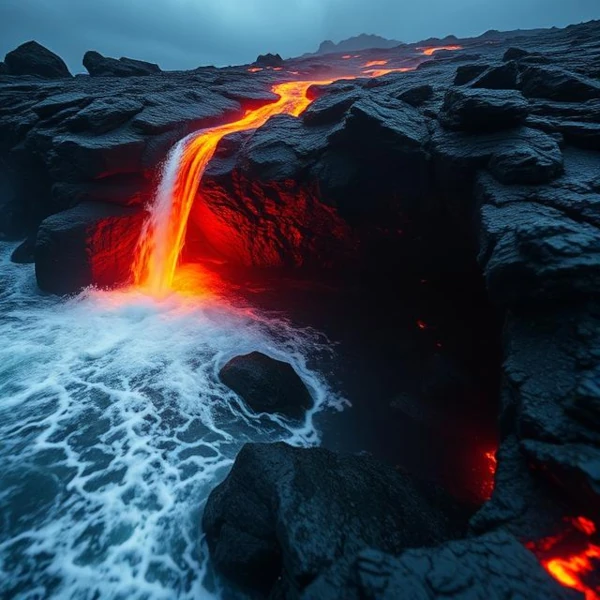
Volcanoes, symbols of destruction and chaos, may well be the unsung architects of life on Earth. Far from the purely catastrophic image often associated with them, these geological titans likely played a crucial role in the emergence of the first life forms about 3.5 to 4 billion years ago. At the interface of fire and water, under extreme conditions of temperature and pressure, prebiotic chemistry may have found its natural laboratory, transforming simple molecules into the fundamental building blocks of life.
Volcanic environments offer a unique combination of conditions favorable to the synthesis of complex organic molecules. Two main types of environments stand out:
One way to imagine this is to compare volcanoes to a giant chemical kitchen. Molten rocks act as hot plates, seawater provides the broth, and minerals serve as spices. From this chaotic yet energy-rich mixture, the first molecular building blocks could have emerged.
Hydrothermal vents, or "black smokers," are geothermal vents located near oceanic ridges. These structures release mineral-rich fluids (iron sulfides, nickel, manganese) at temperatures up to 400°C.
On the emerged lands of the early Earth, volcanic pools, geysers, and hot springs also offered favorable conditions. These environments had the advantage of wetting/drying cycles that could concentrate organic precursors and promote condensation reactions, essential for the formation of biological polymers.
The Miller-Urey experiment (1953) demonstrated that electrical discharges in a reducing atmosphere could produce amino acids. Volcanic environments offer similar conditions with lightning in volcanic plumes and electrochemical gradients at the interfaces between fluids of different compositions.
The walls of microcompartments in porous volcanic rocks may have served as templates for the formation of the first lipid membranes. Similarly, the mineral surfaces of clays and metal sulfides may have catalyzed the polymerization of nucleotides into primitive RNA.
| Type of environment | Temperature | Chemical advantages | Disadvantages/limitations |
|---|---|---|---|
| Alkaline hydrothermal vents | 70-150°C | Pronounced pH gradients, catalytic minerals, porous confinement | Possible thermal degradation of fragile molecules |
| Acidic black smokers | 300-400°C | Significant energy input, reduced minerals | Extreme conditions, destructive acidity |
| Terrestrial volcanic pools | 50-100°C | Concentration/dilution cycles, access to the atmosphere | Environmental instability, exposure to UV |
| Shallow magmatic chambers | >400°C | Maximum geothermal energy, mineral diversity | Conditions too extreme for most organic molecules |
Source: Adapted from Russell et al. (2014) "The drive to life on wet and icy worlds" and Martin et al. (2008) "Hydrothermal vents and the origin of life".
On the early Earth, simple organic molecules had to combine to form the first building blocks of life. This process requires both a support to bring molecules together and energy to overcome thermodynamic barriers. Several natural environments could have played the role of "geological laboratory," each offering particular conditions favorable to prebiotic chemistry.
These five examples show how the early Earth could simultaneously provide the chemical ingredients, catalytic supports, and energy necessary for the formation of the first building blocks of life. Each environment played a complementary role, contributing to transforming an initial molecular chaos into organized chemistry, an essential step toward the emergence of life.
Numerous laboratory experiments have confirmed the potential of volcanic environments for prebiotic chemistry. For example, researchers have reproduced the conditions of hydrothermal vents and observed the spontaneous formation of lipid microspheres and nucleotide polymerization. In the field, the study of hyperthermophilic archaea—organisms living in extreme conditions—suggests that the last universal common ancestors (LUCA) may have been adapted to high temperatures, supporting the hypothesis of a volcanic origin of life.
If volcanoes indeed played a crucial role in the appearance of life on Earth, this suggests that similar environments elsewhere in the solar system could harbor, or have harbored, life forms. Icy moons such as Europa (Jupiter) and Enceladus (Saturn) show signs of hydrothermal activity beneath their icy crusts. Similarly, Mars' intense volcanic past raises the possibility that life may have emerged there in environments now vanished.
Scientists do not all agree on the exact place where life appeared. Was it in a deep ocean near a volcano, in a warm pond exposed to the Sun, or brought by meteorites? What is certain is that volcanoes provided an essential part of the chemical fuel that nourished this adventure.